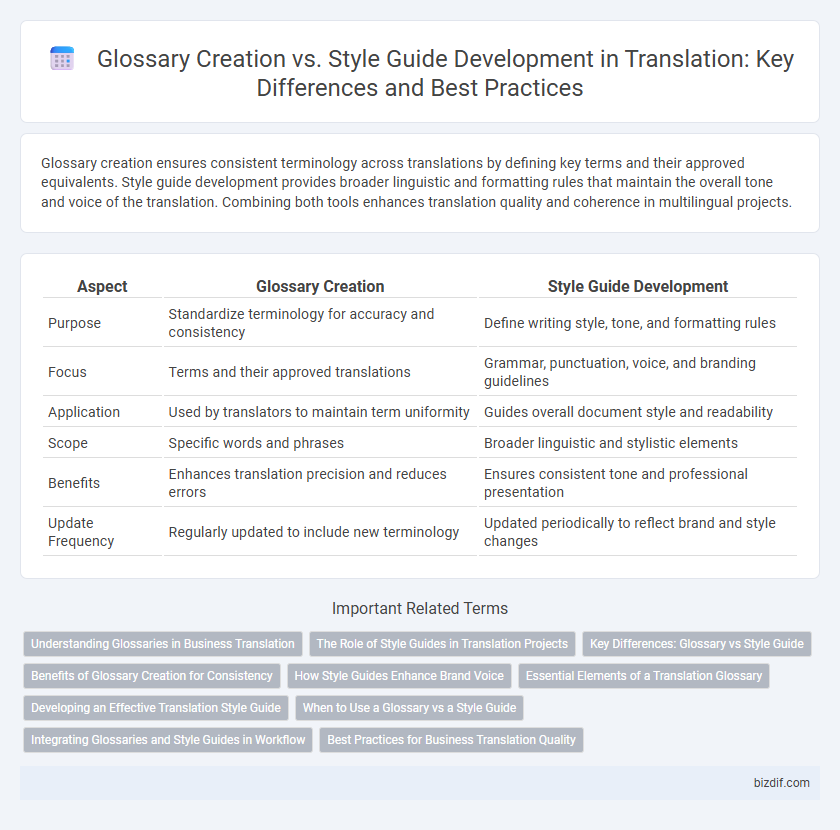Glossary creation ensures consistent terminology across translations by defining key terms and their approved equivalents. Style guide development provides broader linguistic and formatting rules that maintain the overall tone and voice of the translation. Combining both tools enhances translation quality and coherence in multilingual projects.
Table of Comparison
| Aspect | Glossary Creation | Style Guide Development |
|---|---|---|
| Purpose | Standardize terminology for accuracy and consistency | Define writing style, tone, and formatting rules |
| Focus | Terms and their approved translations | Grammar, punctuation, voice, and branding guidelines |
| Application | Used by translators to maintain term uniformity | Guides overall document style and readability |
| Scope | Specific words and phrases | Broader linguistic and stylistic elements |
| Benefits | Enhances translation precision and reduces errors | Ensures consistent tone and professional presentation |
| Update Frequency | Regularly updated to include new terminology | Updated periodically to reflect brand and style changes |
Understanding Glossaries in Business Translation
Glossary creation in business translation involves compiling a targeted list of domain-specific terms with precise definitions to ensure consistency, accuracy, and clarity across multilingual content. Effective glossaries reduce ambiguity and enhance communication by standardizing terminology tailored to industry-specific requirements, such as legal, medical, or technical sectors. Unlike style guides, glossaries focus strictly on term equivalences, playing a crucial role in maintaining brand voice and regulatory compliance during translation workflows.
The Role of Style Guides in Translation Projects
Style guides in translation projects establish consistent language usage, tone, and formatting, ensuring brand voice alignment across all translated content. They complement glossaries by providing detailed instructions on grammar, punctuation, and stylistic preferences that glossaries alone cannot cover. Effective style guide development reduces revision cycles and enhances overall translation quality by guiding translators in adhering to project-specific linguistic standards.
Key Differences: Glossary vs Style Guide
A glossary is a curated list of specialized terms and definitions that ensures consistent terminology usage across translations, while a style guide provides comprehensive rules on tone, formatting, grammar, and punctuation to maintain brand voice and writing style. Glossaries directly impact linguistic accuracy by standardizing key vocabulary, whereas style guides influence the overall readability and uniformity of translated content. Effective translation projects integrate both tools, using glossaries for precise term consistency and style guides for coherent presentation.
Benefits of Glossary Creation for Consistency
Glossary creation ensures consistent use of terminology across all translated content, reducing ambiguity and enhancing clarity for target audiences. It standardizes key terms, which improves translator efficiency and minimizes errors in multilingual projects. Maintaining a comprehensive glossary supports brand voice uniformity and strengthens overall communication quality in global markets.
How Style Guides Enhance Brand Voice
Style guide development enhances brand voice by providing consistent language rules and tone guidelines that align with a company's identity, ensuring all translations reflect the desired personality. Unlike glossary creation, which focuses on terminology accuracy, style guides address broader linguistic elements such as sentence structure, formality level, and cultural nuances. This comprehensive approach guarantees that every piece of translated content conveys a uniform and recognizable voice across all markets.
Essential Elements of a Translation Glossary
A translation glossary primarily includes standardized terminology, language-specific definitions, and context usage examples to ensure consistent and accurate translations. It serves as a linguistic reference that reduces ambiguity and enhances translation quality by providing translators with precise term meanings and preferred usage. Unlike style guides, glossaries focus on technical and domain-specific vocabulary, making them essential tools for specialized translation projects.
Developing an Effective Translation Style Guide
Developing an effective translation style guide involves establishing clear linguistic rules, tone preferences, and formatting standards tailored to the target audience and industry. A well-structured style guide ensures consistency across translations, improving the quality and coherence of multilingual content. Integrating comprehensive glossary management with style guidelines enhances accuracy and streamlines the localization process.
When to Use a Glossary vs a Style Guide
A glossary is essential when consistent terminology is critical across multiple documents or projects, ensuring accurate and uniform translation of specific terms. A style guide is more appropriate for maintaining overall language tone, punctuation, formatting, and writing style preferences to create cohesive and professional content. Use a glossary to standardize vocabulary and a style guide to enforce linguistic consistency and brand voice.
Integrating Glossaries and Style Guides in Workflow
Integrating glossaries and style guides into the translation workflow enhances consistency and accuracy across projects by providing translators with standardized terminology and stylistic preferences. Seamless incorporation of these resources ensures efficient communication among team members and reduces errors, ultimately streamlining translation processes. Automation tools that link glossary terms with style guide rules enable dynamic updates and real-time adherence, optimizing quality control throughout the workflow.
Best Practices for Business Translation Quality
Glossary creation ensures consistent terminology by defining key industry-specific terms and approved translations, which reduces ambiguity and improves accuracy in business translation projects. Style guide development establishes linguistic standards, tone, and formatting rules tailored to the target audience, enhancing readability and brand alignment across all translated content. Integrating both glossary and style guide processes promotes uniformity, streamlines translator collaboration, and ultimately elevates the overall quality of business translation outputs.
Glossary Creation vs Style Guide Development Infographic

 bizdif.com
bizdif.com